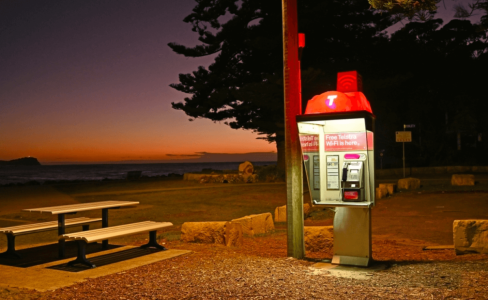Nostalgia or necessity? Why 23 million people are turning to pay phones in a digital age
- Replies 12
We here at the SDC take our hats off to anyone who takes a road trip, as that kind of adventurous spirit (as well as open eyes) often leads to remarkable discoveries.
Just ask Michael O'Brien, who was meandering through Victoria's south Gippsland when he stumbled across an unexpected reminder of the past.
Tucked away in the bushes and off the beaten track in Port Welshpool was a Telstra public payphone.
'The windows were gone, and the fluoro was flickering,' O'Brien told a news outlet. 'It had a dial tone, but I didn't try to call anyone.'
He couldn't resist the urge to capture the sight and shared the image of what appeared to be a cultural relic of a bygone era on a popular Facebook page. The post was flooded with responses from thousands of people.
But turns out this occasional phone booth may not have been as much of a relic as we once thought. In fact, telephone boxes have been enjoying a sudden resurgence in the digital age!
As per official Telstra data, around 23 million payphone calls were made from Telstra's network of 14,500 public phones in the past year—an incredible 4 million increase on the year prior. The major telco made all calls from payphones free in 2021, thanks to a Federal Government initiative designed to help those who need it in regional areas.
A quarter of a million of these calls were even made to emergency services such as triple zero and Lifeline; now that’s something we can all be proud of.
Australia’s most popular payphone, with 33,000 calls made in the last 12 months, is located on Queens Road near a community housing and shelter for the homeless in Melbourne. The second-most popular payphone is by a bus depot in Palmerston, south of Darwin in the Northern Territory.
Cameron Sinclair of Sacred Heart Mission in Melbourne noted that for their unhoused clients, having access to public phones is 'absolutely critical'.
'They can use payphones to call their family and friends, make doctor's appointments and connect to services like Centrelink and the NDIS,' he said. 'For them, the ability to access these things is critical, absolutely critical.'
In addition, Sinclair pointed out that those with fewer digital means and knowledge can take advantage of free connection via some payphones.
'We shouldn't make the assumption that people who are aligned with (charity and homelessness) services are easily identifiable,' Sinclair said.
'They could be your regular mums in the community, single moms, struggling to pay the electricity bill, their rent has gone up. They're just not keeping up.'
With the cost of living continuing to soar and far too many people suffering in its wake, Sinclair believes increased reliance on payphones for communication purposes—both essential and not—is inevitable.
'I think on behalf of the mission, I'd be advocating for putting a whole lot more payphones out there,' he added.

It appears, then, that although technology has advanced leaps and bounds in recent generations, public phones still have a place in our lives.
Even if your circumstances don’t put you into the vulnerable bracket, and you’re better off using your modern gadgets—a mobile phone, say, or Skype—to connect with loved ones, there’s no denying the nostalgia of walking up to a payphone and dialling a number to hear a familiar voice.
Members, have you seen payphones around your local area? Have you seen people use them, or have you used them yourself? We’d like to know, so feel free to comment below!
Just ask Michael O'Brien, who was meandering through Victoria's south Gippsland when he stumbled across an unexpected reminder of the past.
Tucked away in the bushes and off the beaten track in Port Welshpool was a Telstra public payphone.
'The windows were gone, and the fluoro was flickering,' O'Brien told a news outlet. 'It had a dial tone, but I didn't try to call anyone.'
He couldn't resist the urge to capture the sight and shared the image of what appeared to be a cultural relic of a bygone era on a popular Facebook page. The post was flooded with responses from thousands of people.
But turns out this occasional phone booth may not have been as much of a relic as we once thought. In fact, telephone boxes have been enjoying a sudden resurgence in the digital age!
As per official Telstra data, around 23 million payphone calls were made from Telstra's network of 14,500 public phones in the past year—an incredible 4 million increase on the year prior. The major telco made all calls from payphones free in 2021, thanks to a Federal Government initiative designed to help those who need it in regional areas.
A quarter of a million of these calls were even made to emergency services such as triple zero and Lifeline; now that’s something we can all be proud of.
Australia’s most popular payphone, with 33,000 calls made in the last 12 months, is located on Queens Road near a community housing and shelter for the homeless in Melbourne. The second-most popular payphone is by a bus depot in Palmerston, south of Darwin in the Northern Territory.
Cameron Sinclair of Sacred Heart Mission in Melbourne noted that for their unhoused clients, having access to public phones is 'absolutely critical'.
'They can use payphones to call their family and friends, make doctor's appointments and connect to services like Centrelink and the NDIS,' he said. 'For them, the ability to access these things is critical, absolutely critical.'
In addition, Sinclair pointed out that those with fewer digital means and knowledge can take advantage of free connection via some payphones.
'We shouldn't make the assumption that people who are aligned with (charity and homelessness) services are easily identifiable,' Sinclair said.
'They could be your regular mums in the community, single moms, struggling to pay the electricity bill, their rent has gone up. They're just not keeping up.'
With the cost of living continuing to soar and far too many people suffering in its wake, Sinclair believes increased reliance on payphones for communication purposes—both essential and not—is inevitable.
'I think on behalf of the mission, I'd be advocating for putting a whole lot more payphones out there,' he added.
Key Takeaways
- Despite appearing as a cultural relic to some, new usage figures show a high increase in calls made from public payphones in Australia.
- According to Telstra's data, around 23 million payphone calls were made from their network of 14,500 public payphones in the past 12 months, a 4 million increase from the previous year.
- The largest number of calls from a single payphone, nearly 33,000, was made from Melbourne's CBD near community housing and shelters for people experiencing homelessness.
- Cameron Sinclair from Melbourne's Sacred Heart Mission highlighted that public payphones serve as a critical lifeline for many vulnerable and disadvantaged individuals enabling them to stay connected and access essential services.
It appears, then, that although technology has advanced leaps and bounds in recent generations, public phones still have a place in our lives.
Even if your circumstances don’t put you into the vulnerable bracket, and you’re better off using your modern gadgets—a mobile phone, say, or Skype—to connect with loved ones, there’s no denying the nostalgia of walking up to a payphone and dialling a number to hear a familiar voice.
Members, have you seen payphones around your local area? Have you seen people use them, or have you used them yourself? We’d like to know, so feel free to comment below!








